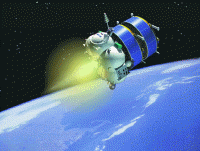Launch Vehicle
 |
 |
| Unmanned Soyuz on launch pad (image courtesy of Starsem) |
Fregat's second qualifying launch, 20 March 2000 |
The Soyuz rocket was first launched in November 1963 and has since flown more than 1500 times. A manned version carries crews to space stations such as Mir, while an unmanned version is used to launch satellites and Progress cargo craft. It is one of the most reliable launch vehicles in the world, with a 98% success rate.
The Soyuz rocket usually comprises three stages:
- Stage 1: four conical boosters grouped around the central core stage
- Stage 2: a cylindrical core
- Stage 3: an upper stage with a payload adapter and fairings
 |
| Cutaway diagram of Soyuz-Fregat launch vehicle (image courtesy of Starsem) |
The four side boosters and the core (first) stage ignite at the same time before liftoff but the lateral boosters shut down and separate first. After the first stage has used all its fuel and separates, the second stage continues to burn. All three stages use liquid oxygen and kerosene fuel.
For the Cluster II launches, a fourth stage, known as Fregat, was added. Its main engine ignited twice so that the stage changed position and the satellites ended up in the correct orbit around the Earth. The Fregat uses UDMH and nitrogen tetroxide as fuel. It is capable of up to 12 restarts.
A number of modifications were made to the Soyuz for the Cluster II launch. The most notable change was the use of a larger than normal (3.7 metre diameter) Soyuz fairing to protect the spacecraft. (This was still smaller than the Ariane 5 fairing, with the result that the radial booms which carry Cluster II's experiments had to be shortened.) The resultant higher aerodynamic forces during liftoff required the rocket's inter-tank section to be strengthened. The third stage also carried a flightcontrol system which was slightly modified to match the larger Fregat fairing.
A new spacecraft adapter for Cluster II was developed by Aerospatiale. The separation system was the standard Ariane version procured from Saab, the same system that was used for Cluster I.
Soyuz facts
| Liftoff weight: | 304 tonnes |
| (of which) Propellant weight: | 279.5 tonnes |
| Height: | 43.5 m |
| Maximum diameter: | 10.3 m |
| Thrust (in vacuum) | |
| - first stage: | 4964 kN |
| - second stage: | 997 kN |
| - third stage: | 298 kN |
| - fourth stage (Fregat): | 19.6 kN |
| Payload capability (to 400 km): | up to 6 tonnes |
Baikonur Cosmodrome
Baikonur Cosmodrome is located at 45.6°N, 63.4°E, in the flat grasslands of the former Soviet republic of Kazakhstan. The area has a continental climate, with long, cold winters and hot, dry summers.
Construction of the secret missile site began in 1955. The first artificial satellite, Sputnik 1, and first human in space, Yuri Gagarin, were launched from Baikonur. All subsequent Russian manned missions have lifted off from there, as well as geostationary, lunar, planetary, and many ocean surveillance missions.
 |
| Soyuz rocket in the vehicle assembly building (image courtesy of Starsem) |
Until recently, the name Baikonur was misleading. The former Soviet Union used the name and co-ordinates of a small mining town, Baikonur, to describe its secret rocket complex. This was done intentionally to hide the true location of the launch complex. In fact, the launch complex is about 230 miles south-west of Baikonur town, near the railway station and village of Tyuratam and close to Leninsk city. However, in 1998, Leninsk city was renamed Baikonur city.
The Cluster II spacecraft was delivered to the cosmodrome by air in March 2000. They were stored in clean rooms and integrated with the Fregat stage inside a modern payload processing facility which was completed in 1997.
The strap-on boosters and stages of the Soyuz booster were assembled horizontally in the large Vehicle Assembly Building. The entire launch vehicle, with its payload, is then transported by rail to the launch pad, where it was vertically erected over a large flame deflector pit. The Soyuz carrying the Cluster II spacecraft was launched from Pad 6.
The Fregat upper stage
 |
| Fregat carrying two Cluster spacecraft into orbit (image courtesy of NPO Lavotchkin) |
The Fregat is a new fourth stage that was developed by NPO Lavotchkin. Financial constraints delayed the development programme until January 2000. The payload was a Russian military remote sensing satellite. The Fregat stage was tested before Cluster II arrived at Baikonur.
Although Fregat is new, each individual component has successfully flown many times. The main engine has already had 30 flights, all successful.
NPO Lavotchkin (Lavotchkin Research and Production Association) was founded in 1937 as an aircraft manufacturer. It later became one of the leading Soviet design bureaux for planetary exploration, participating in the Luna, Venera, Vega and Mars programmes. The centre has extensive experience in building rocket upper stages. Their older 'block L' design has flown 265 times.
Fregat facts
| Diameter: | 3.35 m |
| Height: | 1.5 m |
| Lift off Weight: | 6415 kg |
| (of which) Propellant Weight: | 5350 kg |
| Propellant | |
| - fuel: | Unsymmetrical dimethyl-hydrazine (UDMH) |
| - oxidizer: | Nitrogen tetroxide |
| Main engine thrust: | 19 620 N |
| Main engine specific impulse: | 328 s |
